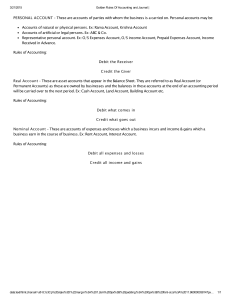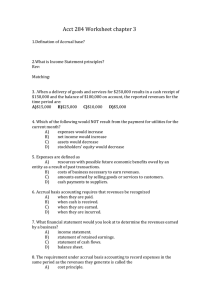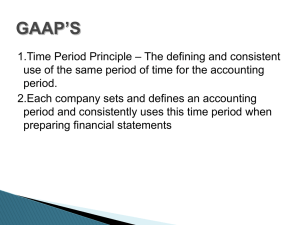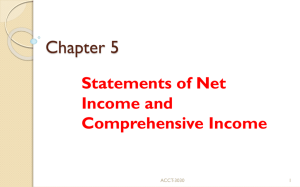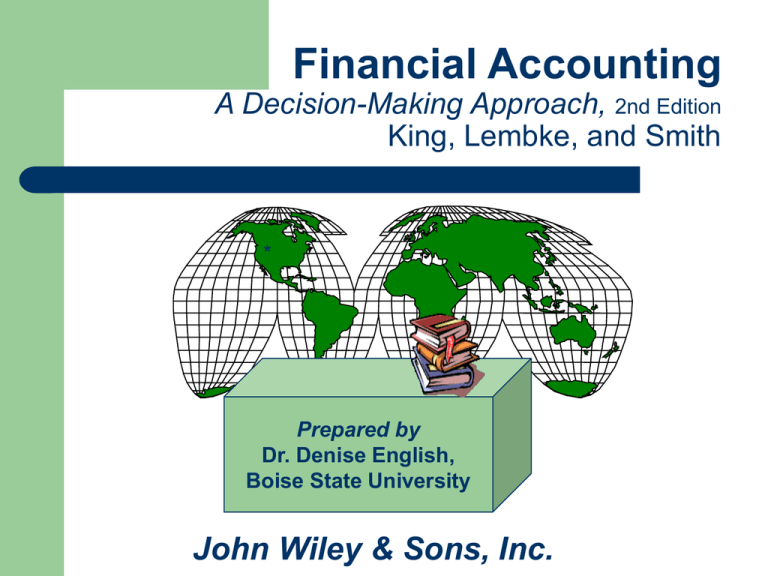
Financial Accounting
A Decision-Making Approach, 2nd Edition
King, Lembke, and Smith
*
Prepared by
Dr. Denise English,
Boise State University
John Wiley & Sons, Inc.
CHAPTER
FIVE
UNDERSTANDING
INCOME
After reading Chapter 5, you should be able to:
1. Discuss what income is and explain its importance for
forecasting.
2. Understand how income recognition is accomplished
in accrual accounting through revenue realization and
expense matching.
3. Explain the difference between cash flow and accrualbasis income, and analyze the relationship between
the two measures of business activity.
4. Describe the elements normally included in income
and reported in the income statement, and discuss
who uses the information and how.
What is Net Income?
Net Income represents the change
in owners’ equity during a period,
excluding the effects of any
additional investments or
withdrawals by the owners.
2) It is computed as the difference
between revenues and expenses.
3) It is also known as net earnings, or
profit; if negative, it is net loss.
1)
The Income Statement
INCOME STATEMENT
-------------------------------------------------------
The Income Statement reports the results of
a company’s activities for a specified period of
time.
It identifies the major sources of income and
the different costs incurred in running the
business.
The bottom line that summarizes revenues
minus expenses is net income.
Operating and
Nonoperating Income
INCOME STATEMENT
-------------------------------------------------------
Operating income is a subtotal reflecting revenues
from sales of a company’s products or services
reduced by operating expenses, or costs of
producing those products or services.
Nonoperating income is a subtotal reflecting
revenues and gains from activities not related to
central operations and not regularly recurring,
reduced by expenses and losses of the same
nonrecurring nature.
The success of a business is judged by its income.
Generating Income vs. Cash Flow
A company must generate sufficient cash to:
–
–
–
acquire resources on a continuing basis;
purchase new assets as existing ones are sold,
used up, become obsolete, or cease functioning
efficiently;
reward owners so they remain interested in
continuing the enterprise.
Income is normally the primary source of
cash for a company.
Internal Users and Uses of
Income Statement Information
Exhibit 5-2
(partial)
Owners/Managers:
Evaluate success in meeting established goals
Compute bonus or other contingent compensation
Project future cash distributions
Determine success in achieving operating efficiencies
Assess success in generating recurring operating income
Manage effects of reported income on taxes and
regulations
Assess success of previous actions
Identify areas for potential cost-cutting or
productivity gains
Internal Users and Uses of
Income Statement Information
Exhibit 5-2
(partial)
Employees and Labor Unions:
Assess stability of employment opportunities
Determine effects of increased pension, health care, and
other benefit costs
Support collective bargaining negotiations
Compute profit-sharing amounts
External Users and Uses of
Income Statement Information
Owners/Investors:
Evaluate success in meeting investment goals
Project future cash distributions
Evaluate performance of management
Assess long-run profit potential
Compare performance with other companies in
industry
Identify areas for potential cost-cutting or
productivity gains through comparisons with
other companies and other periods
Exhibit 5-2
(partial)
External Users and Uses of
Income Statement Information
Exhibit 5-2
(partial)
Creditors:
Assess the adequacy of income to cover interest costs
Evaluate the potential for long-run profitability to provide
adequate cash to retire debt
Determine whether provisions of debt-related agreements
have been met
Vendors:
Assess stability of company as customer
Evaluate credit-worthiness
Project future purchases
External Users and Uses of
Income Statement Information
Taxing Agencies, Regulators, and Public
Interest Groups:
Evaluate relationship between taxable income and
income reported on income statement
Assess fairness of overall return to owners
Evaluate legitimacy and fairness of sources of
income
Evaluate reasonableness of specific expense
categories
Exhibit 5-2
(partial)
I
NC
O
Components of Income
M
E
Revenues are increases in assets from selling
goods and services from an entity’s ongoing
central operations. The following applies to
revenues:
(1) Sales or transfers within the company
(intracompany sales) do not generate revenues.
(2) Income from activities that are peripheral to
the business’s central operations is not included
in revenue.
I
NC
O
Components of Income
M
E
Expenses are the cost of goods and services used
up due to an entity’s ongoing central operations.
They arise when assets are consumed or liabilities
are incurred, and represented expired costs.
Retailers and manufacturers’ most significant
costs are those of either making or buying the
goods they sell to customers.
Service organizations’ most significant costs are
the wage and employee benefits expenses
necessary to render a service to customers.
I
NC
O
Components of Income
M
E
Gains and losses typically occur infrequently
and arise from events not directly associated
with the entity’s ongoing central operations. An
example would be selling a piece of
manufacturing equipment at a price higher
(gain) or lower(loss) than the asset’s accounting
value. Gains increase net income and losses
decrease net income.
I
NC
O
Components of Income
M
E
Nonoperating income and expenses stem
from activities that are incidental to the primary
focus of the business. Examples include
interest income from temporary investments and
rental income from leasing an unused portion of
the company’s factory. Other expenses could
include interest expense and costs of
reorganizing a struggling company.
Income Recognition on the Cash Basis
With the cash basis of accounting, cash receipts
are treated as revenues and cash disbursements
are treated as expenses.
Investments by and distributions to owners are
never included as income (under any basis).
The primary advantage of the cash basis is the
simplicity. It is not considered generally
acceptable for financial reporting, but is widely
used by small businesses that don’t
need audited financial statements.
Cash-Basis vs.
Accrual-Basis Recognition
Exhibit 5-3
ACCRUAL BASIS
Record purchase
Purchase
Inventory
Record sale
Sell
inventory
Pay cash
Record purchase
Record sale
CASH BASIS
Receive Cash
Cash-Basis Revenue Recognition
Case A:
Hot dog
vendor
Case B:
Proctor &
Gamble
Case C:
TWA
Period
1
2
3
4
2
3
4
Sale
Cash
Receipt
1
2
3
Cash
Receipt
Sale
Sale and
Cash Receipt
Period
Period
1
4
Cash-Basis Expense Recognition
Under the cash basis of accounting, cash outflows
are treated as expenses in the period in which
payment is made.
Distributions to owners are never treated as expenses.
Because there is no attempt to recognize expenses in
the same period as the benefits they provide
(matching process), it is difficult to see the period-byperiod results of an entity’s activities.
Accrual-Basis Revenue Recognition
Under the accrual basis of accounting,
revenues are recognized when they are
realized and earned. Generally, two
conditions must be met:
1) An exchange must take place (a
value for a product and service have
been agreed upon).
2) The earning process must be substantially
complete (the critical earning event has
occurred).
Accrual-Basis Expense Recognition
Under the accrual basis of accounting,
expenses are recognized based upon
the matching concept. For each cost,
two determinations must be made:
1) What benefit will be received from
having incurred the cost?
2) When will the benefit be received?
The cost is reported as an expense in
the period in which the associated
benefit is received.
BENEFIT
RECEIVED
RECORD
EXPENSE
Recognition of Gains and Losses
Under the accrual basis of accounting,
gains are generally recognized when
realized, similarly to revenues.
Losses, on the other hand, are recognized
when two conditions exist.
1) It is probable that an asset has been
impaired or a liability incurred.
2) The amount of the loss can be
reasonably estimated.
Relationship between
Income and Cash Flows
A close association between income and cash flows
exists over the long run.
Revenues generate cash inflows, while expenses
generate cash outflows.
When net income is positive, net cash flows should also
be positive.
Because financial reporting occurs in the short run (at
least annually), accrual basis income
?
provides better information for forecasting future cash flows.
Model Company
Income Statement
For the year ended, December 31, 2001
Revenues
Operating expenses:
Cost of goods sold
Selling expenses
General and administrative expenses
Miscellaneous expenses
Total operating expenses
Operating income
Nonoperating income and gains
Nonoperating expenses and losses
Income before income taxes
Income tax expense
Net income
Earnings per share
$ 1,000,000
$ 470,000
150,000
110,000
35,000
___(765,000)
$ 235,000
23,000
___ (8,000)
$ 250,000
(100,000)
$ 150,000
==========
$ 1.50
==========
Reporting Income Statement Elements
Revenues result from the primary
activities of the business enterprise.
Revenues derived from each major
activity should be disclosed.
Revenues may be reported gross or
net, but details of sales returns and
sales discounts are usually
provided in footnotes to the income
statement.
Reporting Income Statement Elements
Operating Expenses include those costs associated with
supporting the central activities of the company; there are
many different kinds of operating expenses:
–
Cost of Goods Sold is often the largest operating expense
and consists of the materials, labor, and other costs of
manufacturing or purchasing products that have been sold
during the reporting period.
Gross Profit or Gross Margin refers to net
sales minus cost of goods sold.
If cost of goods sold and gross profit are
reported separately, a multistep income
statement is provided.
Reporting Income Statement Elements
Marketing, advertising, and promotion expenses reflect costs
related to sales staff, advertising efforts, and prizes and contests
to promote company products or services.
General and administrative expenses relate to the overall
operating costs of the business, such as corporate managements’
salaries and benefits, corporate headquarters’ operating costs,
and costs of new product development.
Interest expense reflects the cost of borrowing; sometimes it is
classified as nonoperating expense.
Other operating income and expenses could
include gains and losses related to a myriad of
circumstances, such as litigation settlements.
Reporting Income Statement Elements
Operating Income is computed as the difference between
revenues and operating expenses and represents income
earned from the central operations of the business.
Gains, losses, and nonoperating items are various items
only peripherally related to central operations, but must be
included in income, nonetheless. Examples include a gain on
the sale of old equipment or an uninsured disaster loss.
Income tax expense reflects the amount of federal, state,
local, and foreign taxes the company expects to pay
based upon its income.
Net income is all-inclusive of everything affecting the
wealth of the business, except investments by and
distributions to owners.
Reporting Income Statement Elements
Earnings per share is the most commonly quoted measure
of operating success. In its simplest form, it is net income
divided by the number of common shares outstanding.
Preferred stock represents a special ownership interest with
rights specified by agreement. Preferred stockholders
usually have a preference over common stockholders in
receiving dividends and assets upon liquidation. Preferred
stocks have fixed dividend rates and no voting privileges.
When computing earnings per share, preferred stock
dividends, if applicable, must be deducted from net
income before dividing by the common shares
outstanding.
Additional Elements
of the Income Statement
Three types of items are classified separately in the
income statement:
1) Income and losses from discontinued operations,
2) Extraordinary gains and losses, and
3) Cumulative adjustments from changes in
accounting principle.
All three must meet special reporting
criteria and are reported “net of taxes”.
Additional Elements
of the Income Statement
Discontinued operations refers to elimination of a
major product line or operating division that has either
been sold or stopped.
Two related presentations must be provided:
1) Gain or loss on the disposal or shut down, and
2) Income (or loss) earned by the segment for the
current reporting period up until time
of disposal or discontinuance.
Additional Elements
of the Income Statement
Extraordinary items are gains or losses that
meet both of the following criteria:
1) Unusual in nature, and
2) Not expected to recur in the foreseeable
future.
Extraordinary items should not be considered
as part of the recurring earnings of the company.
By classifying these items separately, financial
statement users can focus on items of a recurring
nature and better assess performance.
Additional Elements
of the Income Statement
Changes in accounting principle occur as a result of
changes in circumstances. A “catch-up” accounting
adjustment is made so that subsequent financial statements
appear as though the company has always used the newly
adopted accounting principle. Changes in accounting
principle are not a result of operations, but are “paper
events” resulting from a decision to change the way events
are recognized in the accounts.
A
Accounting
methods
B
C
Additional Disclosures
Selected financial statement details for a number of
periods, such as 5-year summaries of net sales and
gross margin results
A summary of significant accounting policies
The amount of repairs and maintenance expense
The amount spent for research and development
An explanation of the computation of income tax
expense
Additional Disclosures
A detailing of significant debt terms and debt
maturities
Information related to the cost of retirement plans
and other postretirement benefits
Sales, income, and assets of different operating
and geographic business segments
Computation of earnings per share
The effects of recent authoritative accounting
pronouncements
Copyright
Copyright © 2001 John Wiley & Sons, Inc. All rights
reserved. Reproduction or translation of this work beyond
that permitted in Section 117 of the 1976 United States
Copyright Act without the express written permission of the
copyright owner is unlawful. Request for further
information should be addressed to the Permissions
Department, John Wiley & Sons, Inc. The purchaser may
make back-up copies for his/her own use only and not for
distribution or resale. The Publisher assumes no
responsibility for errors, omissions, or damages, caused by
the use of these programs or from the use of the information
contained herein.


